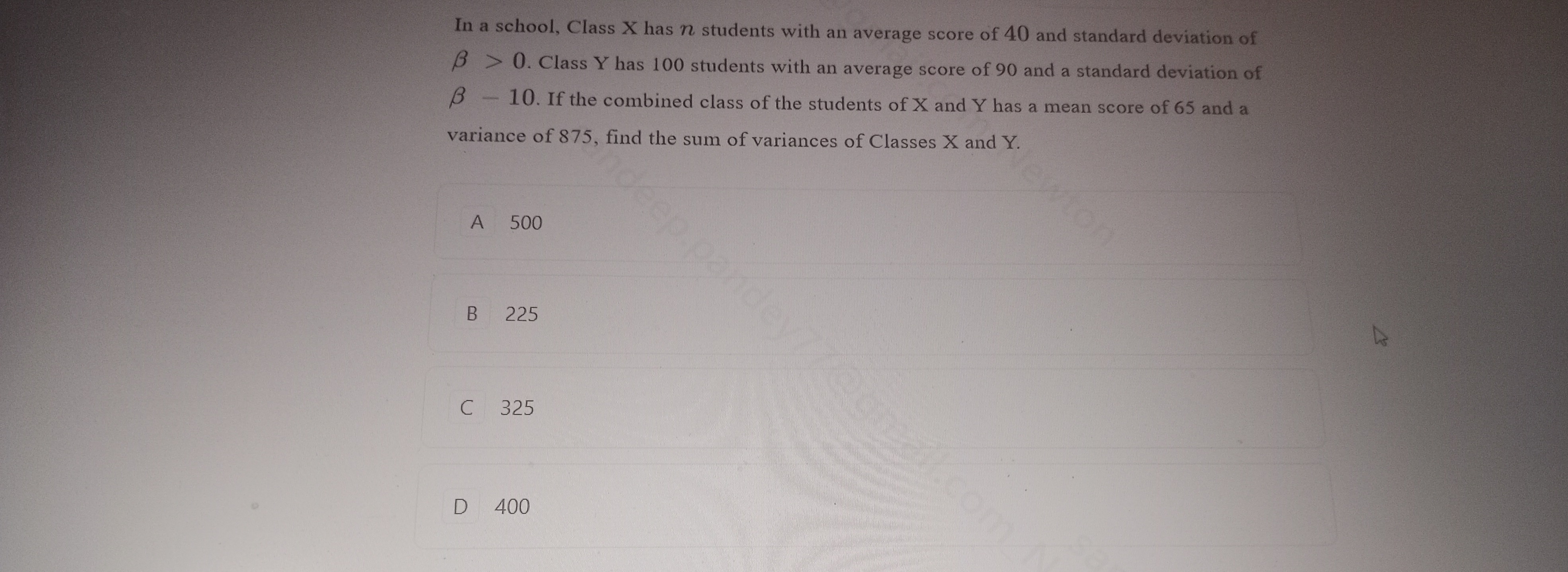Question
Question: In a school, Class X has $n$ students with an average score of 40 and standard deviation of $\beta >...
In a school, Class X has n students with an average score of 40 and standard deviation of β>0. Class Y has 100 students with an average score of 90 and a standard deviation of β−10. If the combined class of the students of X and Y has a mean score of 65 and a variance of 875, find the sum of variances of Classes X and Y.

500
225
325
400
500
Solution
Let n1 and x1 be the number of students and average score of Class X, and σ1 be its standard deviation.
Let n2 and x2 be the number of students and average score of Class Y, and σ2 be its standard deviation.
Let N and x be the total number of students and combined average score of the combined class, and σ be its standard deviation.
Given:
Class X: n1=n, x1=40, σ1=β
Class Y: n2=100, x2=90, σ2=β−10
Combined Class: N=n1+n2=n+100, x=65, σ2=875
The combined mean is given by:
x=n1+n2n1x1+n2x2
Substitute the given values:
65=n+100n×40+100×90
65(n+100)=40n+9000
65n+6500=40n+9000
25n=9000−6500
25n=2500
n=252500=100
So, the number of students in Class X is n1=100.
The total number of students in the combined class is N=100+100=200.
The variance of the combined data is given by the formula:
Nσ2=n1(σ12+(x1−x)2)+n2(σ22+(x2−x)2)
Let d1=x1−x and d2=x2−x.
d1=40−65=−25⟹d12=(−25)2=625
d2=90−65=25⟹d22=(25)2=625
Substitute the values into the combined variance formula:
200×875=100(σ12+625)+100(σ22+625)
Divide by 100:
2×875=(σ12+625)+(σ22+625)
1750=σ12+σ22+625+625
1750=σ12+σ22+1250
σ12+σ22=1750−1250
σ12+σ22=500
The sum of variances of Classes X and Y is σ12+σ22.
σ12=β2 and σ22=(β−10)2.
β2+(β−10)2=500
β2+β2−20β+100=500
2β2−20β−400=0
β2−10β−200=0
Factoring the quadratic equation: (β−20)(β+10)=0.
Possible values for β are β=20 or β=−10.
The problem states β>0 and β−10>0, which means β>10.
β=20 satisfies β>10. β=−10 does not.
So, β=20.
σ1=β=20⟹σ12=202=400.
σ2=β−10=20−10=10⟹σ22=102=100.
The sum of variances is σ12+σ22=400+100=500.
The sum of variances of Classes X and Y is 500.
